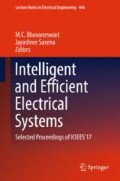Abstract
Artifacts are variations in the desired signal due to other external phenomenon. Major contributors of EEG artifacts are eye movement-related artifacts. As this signal propagates over the scalp, it appears in the recorded electroencephalogram (EEG) as noise that presents serious problems in EEG interpretation and analysis. Hence, preprocessing is required before any further analysis. This paper reports on effective ocular artifact suppression using discrete wavelet transform (DWT)-combined recursive least square (RLS) adaptive noise canceller (ANC) by comparing the mean square error (MSE) and artifact-to-signal ratio (ASR) metrics for the signal obtained in the fronto-polar region where the ocular artifact is dominant.
References
Niedermeyer E, da Silva FHL (1998) Electroencephalography: basic principles, clinical applications and related fields
Birbaumer N (2006) Breaking the silence: brain–computer interfaces (BCI) for communication and motor control. Psychophysiology 43(6):517–532
Goldberger AL, Amaral LA, Glass L, Hausdorff JM, Ivanov PC, Mark RG, Mietus JE, Moody GB, Peng CK, Stanley HE (2000) Physiobank, physiotoolkit, and physionet components of a new research resource for complex physiologic signals. Circulation 101(23):e215–e220
Gilmore RL (1994) American-electroencephalographic-society guidelines in electroencephalography, evoked-potentials, and polysomnography. J Clin Neurophysiol 11(1):1–142
Mallat SA (1999) Wavelet tour of signal processing. Academic press, New York
Peng H, Hu B, Shi Q, Ratcliffe M, Zhao Q, Qi Y, Gao G (2013) Removal of ocular artifacts in EEG—an improved approach combining dwt and anc for portable applications. IEEE J Biomed Health Inform 17(3):600–607
He P, Wilson G, Russell C (2004) Removal of ocular artifacts from electro-encephalogram by adaptive filtering. Med Biol Eng Comput 42(3):407–412
He P, Wilson G, Russell C, Gerschutz M (2007) Removal of ocular artifacts from the EEG: a comparison between time-domain regression method and adaptive filtering method using simulated data. Med Biol Eng Compu 45(5):495–503
Puthusserypady S, Ratnarajah T (2006) Robust adaptive techniques for minimization of EOG artefacts from EEG signals. Sig Process 86(9):2351–2363
Jervis BW, Thomlinson M, Mair C, Lopez JML, Garcia MIB (1999) Residual ocular artefact subsequent to ocular artefact removal from the electroencephalogram. IEE Proc Sci, Meas Technol (IET) 146(6):293–298
Rangayyan RM (2015) Biomedical signal analysis, vol 33, Wiley, New York
Author information
Authors and Affiliations
Corresponding author
Editor information
Editors and Affiliations
Rights and permissions
Copyright information
© 2018 Springer Nature Singapore Pte Ltd.
About this paper
Cite this paper
Prema, P., Kesavamurthy, T., Ramadoss, K. (2018). Ocular Artifact Suppression in Single Trial EEG Using DWT-Combined ANC. In: Bhuvaneswari, M., Saxena, J. (eds) Intelligent and Efficient Electrical Systems. Lecture Notes in Electrical Engineering, vol 446. Springer, Singapore. https://doi.org/10.1007/978-981-10-4852-4_21
Download citation
DOI: https://doi.org/10.1007/978-981-10-4852-4_21
Published:
Publisher Name: Springer, Singapore
Print ISBN: 978-981-10-4851-7
Online ISBN: 978-981-10-4852-4
eBook Packages: EngineeringEngineering (R0)

